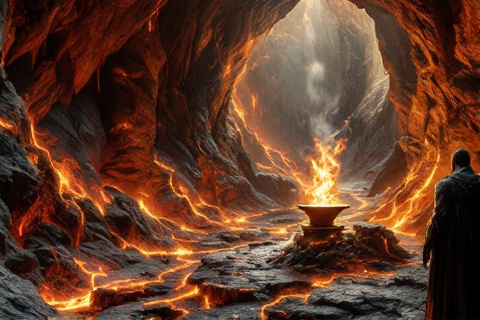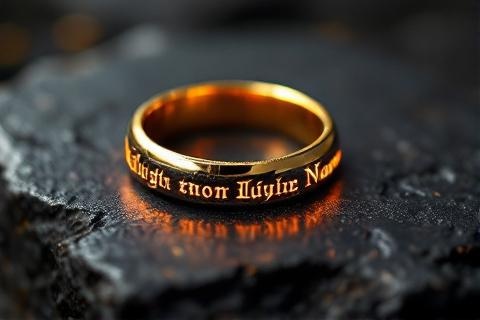
The One Ring: Lord of All Rings
Unraveling the Power and Curse of Sauron's Masterpiece
The Forging of Power: Creation in the Fires of Mount Doom

In the year 1600 of the Second Age, in the fires of Mount
Orodruin (Mount Doom), Sauron forged his masterpiece of evil craft: the One
Ring. The Dark Lord chose this volcanic forge specifically for its immense heat
and connection to the deep powers of Middle-earth. The
creation of the Ring represented the pinnacle of Sauron's skill in ring-making,
a craft he had learned from the Elven-smith Celebrimbor in his
fair guise as Annatar.
The One Ring was no mere magical artifact, but rather a vessel containing a
significant portion of Sauron's own native power and inherent malice. By
investing his power into the Ring, Sauron ensured that his strength would be
preserved and enhanced, though it also meant that his own fate would be forever
bound to that of his creation. This investment of power made the Ring the
mightiest of all the Rings of Power, but also meant
that Sauron would be diminished if ever separated from it.
The forging of the One Ring was the culmination of Sauron's grand design to
dominate Middle-earth through the control of the other Rings of Power. Sauron
had already guided the creation of the Seven Rings for the
Dwarf-lords and the Nine for Mortal Men, while the
Three Elven Rings were made by Celebrimbor alone. When Sauron spoke the
Ring-verse and placed the One Ring upon his finger, his true purpose was
revealed to the Elves, who immediately removed their rings and foiled his
initial plan.
Physical Description: Deceptive Simplicity

The One Ring appears as a simple band of pure gold when viewed in its dormant
state. Its surface is perfectly smooth and unmarked, with no gems or engravings
visible to even the keenest eye. This plain appearance belies its true nature
and power, making it appear deceptively ordinary to the unsuspecting observer.
When heated in fire, the Ring reveals its true nature as ancient letters in
Tengwar script become visible along its surface, glowing with an inner fire that
seems to burn from within the metal itself. The inscription reads 'Ash nazg
durbatulûk, ash nazg gimbatul, ash nazg thrakatulûk agh burzum-ishi krimpatul'
in the Black Speech of Mordor, translating to the infamous
Ring-verse that speaks of its dominion over all other Rings of Power.
The Ring possesses a supernatural durability that makes it impervious to any
normal means of damage or destruction. No ordinary weapon, tool, or craft can
leave so much as a scratch upon its surface. Even the great
dragon Ancalagon the Black could not have marred it with his
fire, as noted by Gandalf in his counsel to Frodo.
One of the Ring's most curious properties is its ability to alter its size to
fit any bearer who claims it. This magical property ensures that whether worn by
the great hand of Sauron himself or the small fingers of a
hobbit, the Ring will always fit perfectly. This adaptability
appears to be one of the Ring's autonomous powers, requiring no conscious effort
from its bearer.
Powers and Abilities: The Ring's Dark Gifts
When worn by mortals such as humans or hobbits, the One Ring renders its bearer
invisible by shifting them partially into the wraith-world. In this state, the
wearer can see the normally invisible world of spirits and shadows, while
becoming invisible to most beings in the physical realm. This effect does not
extend to beings who exist in both worlds, such as the Nazgûl,
who could see Frodo clearly when he wore the Ring.
The Ring grants its bearer an unnaturally extended life span, preserving them
from the effects of age but not truly extending their life in a wholesome way.
As Bilbo described it, the bearer feels 'thin and
stretched,' like butter scraped over too much bread. This preservation comes at
a terrible cost, slowly transforming mortals into wraiths if they possess the
Ring for too long.
For beings of great power, such as Gandalf or Galadriel,
the Ring offers enhancement of their natural abilities to tremendous levels. It
would amplify their existing powers many times over, though this very potential
makes it even more dangerous for such beings to wield, as the corruption would
be swifter and more terrible.
The primary purpose of the One Ring was to dominate the other Rings of Power
and, through them, their bearers. When worn by Sauron, it granted him the
ability to perceive the thoughts and influence the actions of anyone wearing the
lesser rings, except for the Three Elven Rings, which were never touched by him
but were still bound to the One's power.
The Burden of the Ring: Corruption and Influence

The Ring exerts a powerful psychological influence that creates an overwhelming
desire for possession in those who come near it. This desire transcends normal
greed or ambition, manifesting as an all-consuming need to possess and protect
the Ring that overwhelms rational thought and moral considerations. Even the
wise and good can fall prey to this aspect of the Ring's power, as demonstrated
when Boromir attempted to take it from Frodo.
Over time, the Ring works insidiously to corrupt its bearer's mind and spirit,
twisting their noble intentions into darker purposes. This corruption begins
subtly, often manifesting as reasonable justifications for keeping and using the
Ring, before progressing to paranoia, possessiveness, and moral decay. The speed
and severity of this corruption vary depending on the individual's strength of
will and innate power.
The Ring poses its greatest temptation to those who possess significant power or
noble intentions. Beings of great power like Gandalf, Galadriel, and Elrond face
particularly strong temptation because the Ring offers them the ability to
achieve their greatest desires and ambitions. Their wisdom lies in recognizing
that even their noble intentions would be corrupted by the Ring's influence.
While no one can truly master the Ring except Sauron, certain individuals
demonstrate remarkable resistance to its corruption. This resistance is often
rooted in humility and a lack of ambition rather than great power. Hobbits, with
their simple desires and strong mental resilience, prove particularly resistant
to the Ring's immediate influence, though even they cannot withstand its effects
indefinitely.
The Ring's Will: A Mind of Its Own
The One Ring possesses a form of malevolent consciousness, though not in the
manner of a thinking being. Rather, it has a will of its own that actively works
toward reuniting with its master, Sauron. This sentience manifests in its
ability to influence events around it and manipulate the thoughts and actions of
those who possess or desire it.
Throughout its history, the Ring has demonstrated an uncanny ability to abandon
its bearer at crucial moments when doing so might bring it closer to returning
to Sauron. This is not mere coincidence but rather the Ring exercising its will,
as when it slipped from Isildur's finger, revealing him to the orcs, or when it
abandoned Gollum in the Misty Mountains.
The Ring's malevolent consciousness works continuously to corrupt and manipulate
its keeper, exploiting their weaknesses and desires. It does this by amplifying
negative emotions, encouraging possessiveness and paranoia, and gradually
twisting the bearer's perception of reality. The Ring's influence is subtle but
persistent, working even when not worn, as evidenced by its effect on Frodo
during his journey to Mordor.
Notable Ring-bearers Through History

Sauron, as the Ring's creator and true master, maintained the strongest
connection to it throughout its history. His power and very being were
inextricably linked to the Ring, allowing him to regain much of his strength
even while separated from it, though he could never reach his full potential
without it. During the Second and Third Ages, Sauron's actions were largely
motivated by his desire to reclaim this crucial part of himself.
Isildur's possession of the Ring marked a crucial turning point in the history
of Middle-earth. After cutting it from Sauron's hand with the shards of
Narsil, he claimed it as weregild for his father and
brother's deaths. Despite Elrond's and
Círdan's counsel to destroy it, the Ring
immediately began working its influence on him. His brief ownership ended in
tragedy when the Ring betrayed him to his death at the Gladden Fields.
The creature Gollum, once the hobbit Sméagol, demonstrates the Ring's corrupting
influence at its most extreme. After murdering his friend Déagol to claim the
Ring, he was transformed over five hundred years into a twisted, pitiful
creature. His physical and mental deterioration, coupled with his obsessive
attachment to 'his precious,' serves as a stark warning of the Ring's ability to
utterly destroy its bearer.
Bilbo Baggins exhibited remarkable resistance to the Ring's corruption during
his decades of ownership. His initial act of sparing Gollum and his later
ability to voluntarily surrender the Ring (the first Ring-bearer ever to do so)
demonstrate the exceptional resilience of hobbits to its influence.
Nevertheless, even Bilbo showed signs of the Ring's effect, particularly in his
reluctance to give it up and his momentary aggression toward Gandalf when
pressed to do so.
Frodo's tenure as Ring-bearer was marked by both tremendous resilience and
gradual corruption. His journey from the Shire to Mount Doom showcases the
increasing burden of carrying the Ring, particularly as he neared Mordor. While
he maintained his moral character longer than most could have, the Ring
ultimately proved too powerful for even his exceptional strength of will,
leading to his final inability to willingly destroy it at Mount Doom.
Methods of Destruction: The Ring's Only Weakness

The One Ring's unique nature meant it could only be unmade in the exact
conditions of its creation: the fires of Mount Doom where Sauron himself forged
it. The Cracks of Doom within Orodruin contained the only fire hot enough and
sufficiently imbued with Sauron's power to destroy his masterwork. This
requirement necessitated the desperate quest to enter Mordor itself.
The Ring's resistance to destruction was demonstrated by its immunity to even
dragon fire, which could melt lesser rings of power. Gandalf confirmed this when
he told Frodo that not even Ancalagon the Black, the greatest of all dragons,
could have damaged the Ring. Normal forge fires, no matter how hot, would leave
the Ring unblemished.
The necessity of destroying the Ring in Mount Doom presented a nearly impossible
challenge, requiring the Ring-bearer to journey into the heart of Sauron's
realm. This perilous quest formed the central narrative of the War of the Ring,
as the free peoples of Middle-earth sought to achieve what seemed an impossible
task: bringing the Ring to the one place where its destruction was possible.
Legacy in Middle-earth: Impact and Aftermath
The One Ring's influence profoundly shaped the history of Middle-earth for more
than three thousand years, from its creation in the Second Age through the end
of the Third Age. Its existence drove countless conflicts,
shaped the fates of numerous peoples and kingdoms, and maintained Sauron's
influence even when he was seemingly defeated.
The destruction of the One Ring marked the definitive end of the Third Age and
Sauron's power in Middle-earth. This event represented not just the defeat of
evil but a fundamental change in the nature of the world, as the direct power of
the Rings over Middle-earth came to an end. The Fourth Age,
the Age of Men, began with this momentous event.
With the One Ring's destruction, the power of the Three Elven Rings immediately
waned, as their power had always been bound to the One's existence. The great
Elven realms of Lothlórien and Rivendell began to fade,
their power to preserve and protect diminishing without the strength of their
Rings to maintain them.
The end of the Ring's power precipitated the final departure of many Elves from
Middle-earth to the Undying Lands. The Eldar's time in
Middle-earth was drawing to a close, and with their Rings now powerless, many
chose to take the straight road to Valinor. This included the
bearers of the Three Rings: Galadriel, Elrond, and Círdan, along with many of
their kin, marking the diminishing of magic and wonder in Middle-earth.
